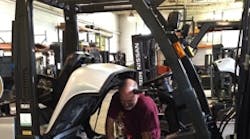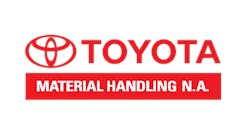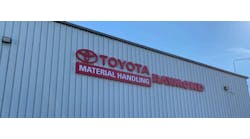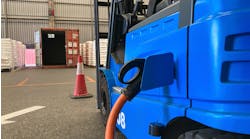During economic hard times lift truck fleet managers have several options when it comes to equipment maintenance. One is to be extra diligent in making sure preventive maintenance gets done so they don’t have to pay extra for unexpected downtime. Another is to save the time and cost required for periodic maintenance and deal with issues as they occur—possibly relying on underutilized equipment as backup for replacement or as a source for spare parts.
Plan B is not a recommended best practice. But either way, when trouble happens lift truck distributors are positioning themselves to be indispensible partners, either at every step along the way or at the last minute, when all else fails. After all, they face the same economic challenges as their customers and it’s in their best interest to keep clients coming back.
With that in mind, MH&L asked a selection of material handling equipment distributors the following questions:
1. How do you keep customers coming back?
2. What are they coming to you for and what does that tell you about them?
In addition to MH&L’s own distributor solicitations, we enlisted the help of the Material Handling Equipment Distributors Association (www.mheda.org) to forward these questions to members around the country. Here’s a sampling of how they responded.
What Do Fleet Managers Want?
“Lower costs” was a popular answer to that question, and distributors are trying to turn that into a win-win proposition for them and their clients by acting as consultants as well as equipment providers.
“We have partnered with one of our largest full maintenance clients to develop annual cost savings measures,” says Jason Milligan, vice president and general manager of the Mobile Equipment Division, Hy-Tek Material Handling (www.hy-tek.net), providers of Yale and Landoll equipment based in Columbus, Ohio. “Our goal is to find ways to help them become more productive using our equipment, our parts and our services, specifically by suggesting savings opportunities as we discover them within their operation. These suggestions include maintenance and operational improvements, facility changes, material flow and operator education as well.”
Distributors are able to go off of some pretty accurate numbers because increasingly, customers are willing to give them access to sensitive operational data.
“We started managing the customers’ data and fleet management and are able to track their cost on a very tight financial model,” says Kenneth Mac Donald, president of M & G Materials Handling Company (www.mandgmaterialshandling.com), which handles Yale, Sellick and Drexel products from their base in East Providence, R.I. “We meet with some customers monthly or quarterly to review their fleet and advise on process improvement or replacement. We can cut the angle down on non-forecasted expenses.”
Financing flexibility is another key desire, considering the economic insecurity many business people still feel.
“Customers are looking for more flexible options in acquiring equipment other than straight purchases or the traditional leasing options,” says James Wilcox, president of Raymond Handling Solutions (www.raymondhandlingsolutions.com), a Raymond Sales and Service Center based in Santa Fe Springs, Calif. “We are offering usage programs with flexibility to change or return equipment during the contract period. Customers are looking more towards access to material handling equipment versus ownership, which is a means to a healthier balance sheet and operational flexibility.”
That often means leaving maintenance to the distributor as well.
“Along with the continued reliance on fair market value leases to ensure repeat business due to lease terminations and new replacements, we work very closely with our customers on total fleet maintenance and utilization,” says Gary Hansen, vice president of Capital Equipment & Handling (www.cehnissan.com), a Nissan and Clark dealer based in Hartland, Wis. “We can help reduce our customers’ overall cost of ownership by reducing maintenance cost, many times by use of guaranteed full maintenance (GFM) and by increasing equipment productivity and improving utilization. Sometimes it comes down to reducing their fleets to meet actual demand as opposed to having trucks there because they think they need them.”
Service is expanding beyond lift truck upkeep to designing the right work environment for that equipment.
“The fundamental business changes our customers experience through expansion/consolidation, merger/acquisition, or changes in their product mixes provide opportunities for us to be creative in warehouse design and in application of material handling and storage methods,” says Steve Raymond, president of Raymond Handling Concepts Corporation (www.raymondhandling.com), a Raymond Sales and Service Center in Fremont, Calif.
But business changes also require maintaining a flexible and capable staff and distributors are adding human resource development to their responsibilities.
“Many of our customers are looking for education on new methodologies and technologies that will allow them to operate at a high level of efficiency with minimal capital investment,” says Mike Romano, president and CEO of Associated Integrated Supply Chain Solutions (www.associated-solutions.com), which handles Raymond products and is headquartered in Addison, Ill. “Education initiatives are aimed at providing access to information on practical solutions concerning the industry’s current hot topics, including frequently-held educational sessions hosted by supply chain thought leaders.”
Topics of such educational sessions can go beyond the lift trucks themselves and include issues that affect the entire company.
“Dealerships that demonstrate the ability to address challenges such as energy consumption and safety and environmental concerns can mitigate customer price objections by solving broader issues,” says Bret Bruin, national dealer development manager for Toyota Material Handling U.S.A., Inc. (www.toyotaforklift.com).
These broadening services are a reflection of the fact that the purchasing decision is rising in many organizations, and therefore, so are customer expectations. But that can also lead to unrealistic expectations as well, and distributors must be careful about adjusting their offerings to those buying influences.
“Since more and more of the purchasing decisions have moved up the ladder to the CFO levels, there seem to be more final decisions made only looking at the short term benefits of the lowest price,” says Audie Burgan, president at JM Equipment (www.jmequipment.com), providers of Nissan and Hyundai lift trucks on the West Coast. “We are constantly looking for the angle to convince the decision makers to look more long term.”
What Are Distributors Seeing?
It’s not enough for distributors to rely on conversations with their customers to determine needs. A plant tour is worth a thousand words, and lately distributors have been getting visual cues about how they need to build their product and service offerings.
“Most recently we have seen resurgence in the use of tuggers to move material on carts to manufacturing lines,” says Hy-Tek’s Jason Milligan. “This is a more manual practice, but it can be a more practical application. Some customers are choosing to revisit simpler, less costly, technology to better meet the needs of quick product changes and manufacturing variability within their markets.”
That simplicity must be supported by safe operating procedures and M&G’s Kenneth Mac Donald says he’s seeing an uptick in attention to OSHA compliance.
“OSHA is a little more active in a down economy,” he says. “One company this month spent over $8,000.00 in parts to get back in compliance. That did not include the fines they were assessed. Customers who stop complying with the OSHA safety standards are exposing employees to dangers and also litigation cost.”
Those hazards may increase as staffs get leaner and workloads get heavier.
“Customers are more cautious with hiring employees, so they have the minimal amount of equipment on the floor,” says James Wilcox of Raymond Handling Solutions. “In turn we are providing more flexible access to equipment. Also, automation projects and fleet optimization tools are helping customers improve their current operations.”
Another regulation-driven improvement is emphasis on a cleaner work environment, and a cleaner environment in general. On the West Coast, the California Air Resources Board (CARB) has forced those with internal combustion engine powered lift trucks to consider alternatives.
“In California, the driving request is still ‘Green Technology,’ says JM Equipment’s Audie Burgan. “[For managers of IC fleets,] the initial shock of acquisition of electric power has to be followed up with a detailed comparison of the long term benefits and cost savings. There is still a huge fear among IC users that have little or no experience with electric power.”
Training and education will not only diminish those fears, but distributors are making the point that the resulting improvement in productivity and safety will contribute to ROI. But it’s not enough to trust that such training has been effective, particularly where safety is concerned.
“More and more customers have been putting tracking and impact managers on their equipment,” says Gary Hansen of Capital Equipment & Handling. “This is reducing overall costs due to misuse, abuse and damage by unauthorized or undertrained personnel. That bodes well for growth in this still tight economy, with an eye on total fleet accountability and controlled expansion.”
Michael Pentinge, vice president of sales for Abel Womack, Inc. (www.abelwomack.com), a Raymond Sales and Service Center adds that smarter labor management is a key element of that expansion.
“More than 70 percent of the cost of operating a lift truck over its life is in the operator and customers are looking for ways to reallocate their employees or at least track what each piece of equipment and each operator is doing during the course of a shift.”
So, in a strange way, economic hard times have forced companies to improve their operations.
“During good times, companies didn’t manage operator performance like they are today,” says Brett Levin, sales manager with Material Handling Supply (www.mhslift.com), a Crown and Nissan dealer headquartered in Brooklawn, N.J. “Abuse was tolerated more. That’s why fleet management services have become the primary topic of discussions with our customers and prospects.”
Mike Romano of Associated Integrated Supply Chain Solutions is seeing the paybacks from this expanded emphasis on efficiency.
“Many of our customer’s operations are leaner, faster and more productive than ever,” he says. “They’re looking at the big picture. Instead of sourcing the fastest forklift to get their products from point A to point B, they are looking for the most efficient process. The economic downturn forced many companies to reevaluate their order fulfillment processes to reduce cost. As a result many of them found that reducing cost did not have to mean their productivity would suffer, in fact it can increase.”
Related Articles:
How Distributors Make Best Practices Better
Keep Problem Parts Out of Your Equipment



